The Etruscans
Early Etruscan Inscriptions
Home Cities History Art Hagiography Contact
The Etruscans: Main page Etruscan Language and Culture
Early Etruscan Inscriptions Etruscan Religion
Return to the History Index


The Etruscans
Early Etruscan Inscriptions
Home Cities History Art Hagiography Contact
The Etruscans: Main page Etruscan Language and Culture
Early Etruscan Inscriptions Etruscan Religion
Return to the History Index
Vetulonia
Stele of Avele Feluske (late 7th century)
This funerary stele, which is now in the Museo Archeologico Isidoro Falchi, depicts a warrior behind a circular shield. He is armed with a double-headed axe and naked except for his Greek helmet. The stele contains one of the earliest surviving Etruscan funerary inscriptions, which identifies the deceased as Avele Feluske, son of Tusnute and [...]panalas. It also identifies the donor as "hirumina phersnalas", which might mean Hirumina of Perugia.
This stele is strongly reminiscent of the so-called Stele of Lemnos (6th century BC), from Kaminia on the island of Lemnos, which is now in the National Museum, Athens. (There is an interesting article and an illustration of the stele in the website of Dieter H. Steinbauer). This has a long inscription in a language with many similarities to Etruscan, prompting a number of theories as to why these two cultures should be so closely related.
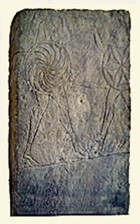
Perugia
Alfabetario di Perugia (late 6th century BC)
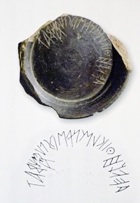
✴The main part of the inscription sets out the Etruscan alphabet, using 19 letters from the version of the Greek alphabet that was used in Corinth. This is in a form that is typical of those from Chamars (Chiusi) at this period.
✴The last four letters seem to have been added later: they are transcribed as “abat”, which might mean “alphabet” or perhaps “a, b” (as in the English expression “abc” for the alphabet).
The “alfabetario” is now in the Museo Archeologico, Perugia.
Ipogeo degli Acsi (late 6th or 5th century BC)
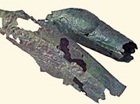
arnth savpunias turce menrvas
Arnth Savpunius gave [these] to Menrvas (Minerva)
It is possible that the shin guards were dedicated at Volsinii (Orvieto), and that they found their way to Perusia and more specifically to the Tombe degli Acsi after the fall of Volsinii in 264. They are now in the Museo Archeologico, Perugia.
Orvieto
Funerary Inscription (6th century BC)
A tomb in the Cannicella Necropolis has an interesting Etruscan inscription:
[m]i aviles katacinas"
I am [the tomb of] Aviles Katacinas
The deceased had an Etruscan-Latin first name (Aule, Aulus) and a family name that is probably of Celtic origin.
Inscription (ca. 550 BC)

This inscription “thval veal” reveals that the temple associated with the Cannicella Necropolis was dedicated to Vei (Demeter). It is now in the Museo Civico.
Inscribed Warrior Head (ca. 550 BC)
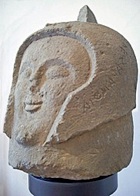
larth cupures aranthia
Larth Cuperes, son of Aranth
This name is unlike others found in Orvieto, and it is thought that Larth might have been a foreign mercenary who settled in the city.
The cippus is now in the Museo Civico.
Funerary cippus (late 6th century BC)
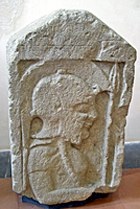
Inscribed Base for a Statue (ca. 500 BC)
The Etruscan inscription, which is in two lines on each of two sides, has been transcribed:
kanuta larecenas lauteniθa aranθia pinies puia turuce
tlusχval marveθul faliaθere
Kanuta, freedwoman of the Larecena, wife of Aranth Pinie, has offered ... [this statue?] to Tluschva
This deity is named three times on the famous “Piacenza Liver” (as “Tlusc”, “Tluscv”, “Mar Tlusc”) and also appears in another recently-discovered inscription from Cerveteri. This deity (or group of deities) is usually taken to be female, and to be chthonic (related to the underworld):
✴“Tluschval” (as in the Orvieto inscription) seems to be a genitive form of the plural;
✴in his webpage, Glen Gordon suggests that “Tluschva” is “a single god [named for] a pluralized inanimate concept”, specifically “depths”.
The translation of the fuller name in the inscription at Orvieto (“tlusχval marveθul faliaθere”) is still debated among scholars:
✴ Giovanni Colonna (referenced in the page on Campo della Fiera) suggests that “marveθul” derives from “maru” (magistrate).
•He goes on to suggest that, in this inscription, it is an epithet that signifies “minister, acolyte or helper”, perhaps of Hades, the god of the underworld; while
•Simonetta Stopponi (in the appendix to the article of 2011 referenced in the page on Campo della Fiera) suggests that the magistracy in question was connected to the construction of public buildings, and translates “marveθul” as “of the seat or residence”.
✴“faliaθere” might be a locative related to “faladum”, a Latinised Etruscan word that Festus translated as “coelum” (heaven). Simonetta Stopponi (in the appendix mentioned above) translates it as “in the celestial place”, and tentatively suggests that this is the Etruscan name for the sanctuary at Campo della Fiera.
The inscription is now in the Museo Archeologico.
Inscription (ca. 4th century BC)
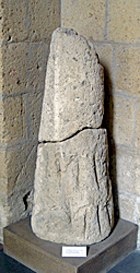
TINIA TINSCVIL
and probably formed part of an altar dedicated to Tinia (Zeus, Jove) from a temple on the site.
Inscriptions from Golini Tombs I and II (4th century BC)
The archaeologist, Domenico Golini discovered the so-called Golini tombs in 1863 in a hillside at Settecamini, outside Orvieto. They belonged to a number of aristocratic families that had probably had country estates nearby. Two of the tombs (Golini I and Golini II), which were on the higher part of the hillside, were distinguished by a series of frescoes painted on their walls. These were detached in 1950 and moved to the Museo Archeologico of Florence. They were transferred to Orvieto in 1982 and are now displayed in the Museo Archeologico.
Golini Tomb I
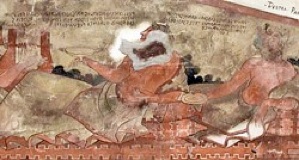
The most important inscriptions on these frescoes describe two men who were presumably buried in the tomb, and who are portrayed at a banquet in the Underworld:
Arnth Leinies; and
Vel lecates, brother of Arnth,
both of whom are described as “son of Larth, grandson of Vel”.
Vel Lecates
Vel lecates arnthial ruva larthialisa clan velusum nefs
marniu spurana eprthnec tenve
mechlum rasneas clevsinsl zilachnve
pulum rumitrine thi ma[l]ce clel lu(puce) (TLE 233)
The first line identifies Vel as “brother of Arnth, son of Larth, grandson of Vel”. Jacques Heurgon (referenced below) suggests that “lecates” was an honorific meaning “legate” or ‘emissary”. In the last line of the inscription, which presumably describes the high point of Vel’s public career, relates something that he did : “pulum rumitrine”, which Heurgon suggests means “in Rome”.
Adriano Maggiani (referenced below) has used this and similar inscriptions to establish the names of the various magisterial offices used in the cities of Etruria in the pre-Roman period. Those that had been held by Vel are listed in the inscription as:
maru - marunuch;
purth - eprnevc; and
zilath - zilach.
The words in these pairs are related as in: “magistrate - magistracy”, and are listed here in ascending order of seniority. Adriano Maggiani makes the following observations on the way some of these magistracies are qualified.
✴In “marniu spurana”, the word spurana seems to mean “civic”, ‘urban” or “public”.
✴The office of “zilath mecl rasnal” seems to have been the highest in each of the Etruscan city states. If this is correct, then as “mechlum rasneas clevsinsl zilachnve”, Vel would be the chief magistrate of Clevsin (Chiusi).
Arnth Leinies
Arnth Leinies larthial clan velusum nefts
ailf() marunuch tef esari
'ru[va] l[ecates velus] amce (TLE 234)
The first and last lines identify Arnth as “brother of Vel, son of Larth, grandson of Vel” and “brother of Vel lecates” respectively. The magistracy held by Arnth might have been religious in character.
Vel Leinies Junior
Vel leinies larthial ruva arnthialum clan velusum prumaths
avils semphs lupuce (TLE 232)
Vel Leinies, brother of Larth (junior), son of Arnth, great grandson of Vel
he died (lupuce) at the age of 7
This younger Larth, Vel’s brother, is identified in the fresco as a young man driving a chariot towards the Underworld to join Vel, their father Arnth and their uncle (Arnth’s brother) Vel lecate.
Golini Tomb II
Golini Tomb II is also known as the tomb of the two chariots because of the chariots that were depicted on each side of the entrance. The other walls depicted scenes from a feast in the underworld. The inscriptions refer to two families: Cnezus on the left; and Vercnas on the right.
Read more:
A. Maggiani, “Republican Political Forms”, in
M. Torelli (Ed.), “The Etruscans”, (2000 ) New York, pp. 227-41
A. Feruglio, “Necropoli del Territorio: Le Tombe Golini I e II in Località Settecamini”, in
P. Bruschetti and A. Feruglio, “Todi-Orvieto”, (1999) Perugia, pp. 155-71
J. Heurgon, “Un Legatus à Volsinii: à Propos des Inscriptions de la Tombe Golini I”, Mélanges de l'Ecole Française de Rome: Antiquité, 86:2 (1974) 707-21
The Etruscans: Main page Etruscan Language and Culture
Early Etruscan Inscriptions Etruscan Religion
Return to the History Index